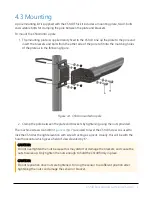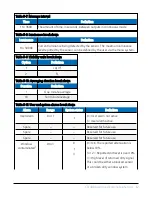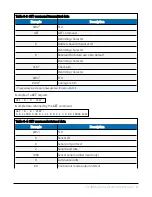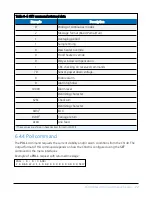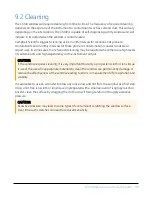
Table 6-1: Command line variable definitions
ID
Name
Range
Description
Default
15
Power Supply Unit
(PSU) voltage level
shutdown
9 to 30
PSU input voltage level below which
the CS140 will enter low power mode.
This helps protect the batteries.
NOTE:
The CS140 shuts itself down via
hardware at about 8 VDC.
9
16
Enable alarm
0 or 1
0 = Alarm off
1 = Alarm on
0
17
Alarm high/low
0 or 1
0 = Alarm triggered by a luminance
higher than the alarm level
1 = Alarm triggered by a luminance
lower than the alarm level
0
18
Alarm level
0 to 45000 Luminance level, in cd/m
2
, that triggers
the alarm.
10000
1
Hood heater override needs to be set to 1 (off) when the hood heater has no power connected. This will save
power as the relay is not enabled at low temperatures in this mode.
2
If disabled the sensor does not check the validity of received data against the checksum sent. It is, however,
recommended that checksum checking is enabled to remove any chance of the CS140 being configured
incorrectly by accident.
6.4
Command
line
mode
The
command
line
interface
is
broken
down
into
three
major
commands.
These
are
GET
,
SET
and
POLL
.
The
GE
T
command
is
used
to
request
all
current
user
settable
values
from
the
CS140.
The
SET
commands
sets
user
settable
values
and
the
POLL
command
is
used
to
request
the
current
visibility
and/or
alarm
conditions
from
the
sensor.
The
CS140
can
be
configured
to
expect
any
commands
sent
to
it
to
include
a
valid
checksum.
For
simple
commands
such
as
GET
and
POLL
,
fixed
value
checksums
can
be
used.
For
more
complex
SET
commands
the
checksum
needs
to
be
calculated.
The
use
of
the
checksum
is
disabled
by
default.
Campbell
Scientific
recommends
enabling
the
checksum
functionality,
especially
when
long
cable
runs
are
used,
or
in
electronically
noisy
environments.
provides
example
code
for
programmers
implementing
their
own
code.
For
CS140 Background Luminance Sensor
18




